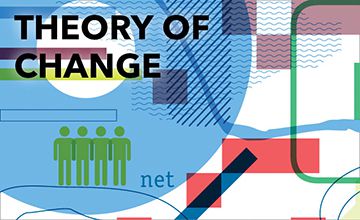
Table of Contents
What is Theory of Change (TOC)?
- Theory of change (TOC) is a detailed description and illustration of how and why the desired change is expected to happen in a particular situation.
- A theory of change explains how activities are understood to contribute to a series of results that produce the final intended impacts. – UNICEF
- Theory of change is a purpose driven model that shows how a plan/project/strategy/ intervention contributes to achieve the intended result – through a chain of short-term, mid-term and long-term outcomes.
- Theory of change promotes social changes and defines long-term goals.
- Theory of change is also a blueprint for evaluation.
- It provides a roadmap to reach from here to there.
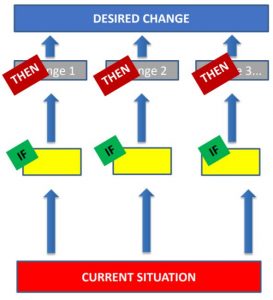
- Theory of change is the continuous process of reflection to explore change, how it happens, and the importance of changes in a particular environment, sector, and group of people.
- It can be presented in visual or narrative or both forms.
- A theory of change is a statement/illustration explaining an organization attitude toward social change that connects its mission and strategy to the program.
- Basically, theory of change comprises of long-term goals, measurable indicators of success and actions to achieve the goal.
- In an impact evaluation, the existing theory of change should be reviewed and revised as needed to guide data collection, analysis and reporting.
- Theory of Change comprises of the description of the:
- Target population
- Expected outcomes
- Classified program activities
- Indicators
- Measurement tools and
- Uses of data
- A Theory of Change can be the basis for a results framework and can easily be created from a log frame to do a gap analysis.
- The Theory of change diagram is flexible and does not have a particular format. It could be cyclical processes, feedback loops, one box could lead to multiple other boxes or other different shapes.
Components/Elements of Theory of Change:
Basically, there are five components/elements of theory of change:
- Problem statement
- Strategies
- Inputs
- Activities
- Target population
- Assumptions and risk
- Outputs (short term results)
- Outcomes (mid-term results)
- Impact/Final goal (long-term results)
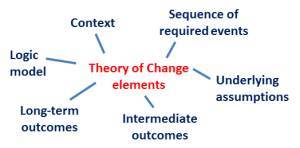
Qualities of Theory of Change:
Theory of change should be CAST:
- Credible: based on experiences, proven experiments and valuable insights of intellectual people.
- Achievable: achievable in terms of resources and feasibility.
- Supported: supported by different concerned stakeholders
- Testable: having specific outcomes and measurable indicators.
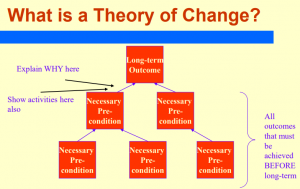
Diagram showing the design of a ToC (reproduced from Clarke and Anderson, 2004).
Why is Theory of Change (TOC) Important?
- Theory of Change leads to better planning.
- Helps us to grab detailed understanding of how change actually happens through the planned activities
- TOC provides a basis for evaluation.
- Theory of change explains how the activities undertaken by an intervention contribute to a chain of results that lead to the intended or observed impacts.
- To measure progress towards achievement of long-term goals
- A good theory of change encourages a deep observation of the system.
- It helps to identify and open up the “black boxes” in our perspectives.
- It focuses on the importance of working with “non-usual” suspects.
- It helps to answer the importance and requirement of strategic partnerships to complete a task.
- A Theory of Change examines our ideas or assumptions of how change is expected to happen.
- Theory of change is the key foundation of non-profit performance management and use of key data towards effectiveness on the given task or mission.
Features/Characteristics of Theory of Change:
- Reflects present status and our goal.
- Reflects all the different pathways that might lead to change.
- Describes/illustrates how and why the changes takes place.
- Helps to give logical reasoning “If we do A, then we get B because of …..reasons”.
- Can be presented in diagram or narrative or both.
- The diagram or illustration is flexible and does not have a specific format.
When should we create a theory of change?
- Theory of change can be created at multiple stages of the program.
- It is particularly useful when the intention is to learn from an impact evaluation conducted at one site and then apply these lessons to another site.
- Likewise, it is also best time to create theory of change is while designing the program.
- However, it can also be prepared in other phases of the program as well;
- While designing the program
- During team building and forging collaboration
- While developing an action plan
- Before data collection.
- Before the beginning of an evaluation
Questions that Theory of Change Answers:
While developing a theory of change, we need to ensure that it addresses following six question:
- Situation analysis/external context?
- Who are the beneficiaries?
- What are the expected results/benefits?
- What is the expected time period to achieve the results?
- What are the proposed interventions?
- Why, and based on what evidence, can we believe that the theory of change will achieve the expected results (assumptions)?

How is Theory of Change different from other models?
- TOC clearly shows a causal pathway from present to future.
- It describes/illustrates the activities and interventions required to achieve the goals.
- It demands underlying assumptions that can be tested and measured.
- It shows the gap between where we are, where we want to reach and ways to reach there.
What are the Steps to Develop/Prepare Theory of Change?
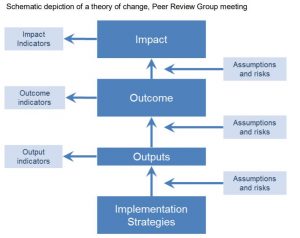
In short, following steps can be followed to prepare theory of change.
- Firstly, identify the desired long-term goal of the program/project.
- Conduct “backward mapping” i.e., work backward to identify the conditions (outcomes) that are required to achieve the goals.
- Make sure that all these conditions/outcomes are related to each other.
- Develop indicators for each outcome that will be used to assess the performance of the interventions.
- On the basis of the outcomes, identify what kind of activity or intervention will help to achieve those outcomes.
- While developing the activities, ensure that there is accurate and specific link between activities and long-term goals.
However, in detail, following steps can be followed for preparing theory of change.
Detailed Steps to Prepare Theory of Change:
The steps that should be followed while developing theory of change are:
1. Situation analysis/context analysis
Situation analysis provides a glimpse of the situation. It helps to know the present status of the local and national level which is required to plan the project further.
- What is the problem, issue, or opportunity? Describe its nature and extent
- Who are suffering from the problem: individual, household, group, community, organization, society in general, particular locations?
- What is the background/history of the problem, and what projections are there about its future?
- Why does the problem occur? What are the different causes? Are some causes more important or influential than others? Are there known causal pathways that produce this problem?
- In the past, has anything been effective or not effective while addressing this problem?
- What are the consequences of the problem (direct and indirect consequences)?
- Why should the problem be solved? What benefits will it deliver?
Adopted from From: Funnell & Rogers 2012, Purposeful Program Theory San Francisco: Wiley/Jossey-Bass, pp160-161.
2. Clarify the program goal
- This step clarifies or explains the program goal, objectives, and vision.
3. Design the program/product
- In this step, the program, interventions and activities are designed.
- It looks from both demand and supply side aspect.
4. Mapping the causal pathway/ Building a Theory of Change
Systematically laying out the theory-connecting program to the goal.
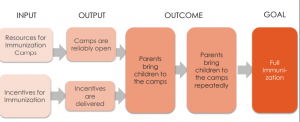
5. Explicate assumptions
This step explains assumptions and assumes it during the program to achieve the program goals.
6. Design SMART indicators
In this step, indicators for each component are designed
Indicators are:
- Signals of change
- Measures of progress
Indicators should be SMART:
- Specific – Ask (answer) one question at a time
- Measurable – Quantifiable, accurate, unbiased, sensitive
- Achievable – Is the indicator realistic?
- Relevant – Is this the most relevant program indicator given the needs
- Time-bound – Measured over a period of time
Application of Theory of Change in programs/projects:
- A theory of change starts by identifying a clear ultimate goal and working backward to establish preconditions for reaching that goal.
- A theory of change is developed in the course of the planning stage and useful for monitoring and evaluation.
- It helps in specifying a range of conditions that help programs deliver on the desired outcomes
- A good theory of change helps to:
- develop better key evaluation questions
- identify key indicators for monitoring
- identify loopholes in available data
- prioritize further data collection
- provide a framework for data analysis and reporting.
- Likewise, the theory of change helps to answer the following questions during the program:
- What is the program?
- What is the goal and objective of the program?
- What outcomes does the programme aim to achieve?
- What intermediate steps lead to those outcomes?
- What assumptions are associated with each link in the causal chain?
- How can we measure outcomes?
References and For More Information:
https://www.theoryofchange.org/what-is-theory-of-change/
https://usaidlearninglab.org/lab-notes/what-thing-called-theory-change
https://assets.publishing.service.gov.uk/media/57a08a66ed915d622c000703/Appendix_3_ToC_Examples.pdf
https://link.springer.com/chapter/10.1007/978-981-10-0983-9_24
https://trialsjournal.biomedcentral.com/articles/10.1186/1745-6215-15-267
https://www.aecf.org/resources/theory-of-change/
https://www.betterevaluation.org/sites/default/files/Theory_of_Change_ENG.pdf
https://www.betterevaluation.org/en/node/5280
https://oxfamblogs.org/fp2p/what-use-is-a-theory-of-change-6-benefits-and-some-things-to-avoid/
https://www.dgmt-growingconfidence.co.za/content/why-theory-change-important
http://learningforsustainability.net/theory-of-change/
https://www.betterevaluation.org/en/rainbow_framework/define/develop_programme_theory
https://www.betterevaluation.org/en/node/5280
https://knowhow.ncvo.org.uk/how-to/how-to-build-a-theory-of-change